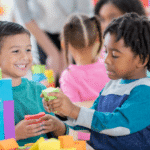Young children retain information better when educators are able to tap into their preferred learning styles. This approach allows kids to capitalise on their strengths and keeps them motivated to progress along the curriculum at their own pace.
Making a child’s preferred learning style the baseline for their education also nurtures in them a love of lifelong learning, which can significantly impact their academic performance and their self-determination. The challenge for parents and teachers lies in figuring out a child’s learning style and, as a result, how to create a positive learning environment that encourages them to utilise their skills to their fullest.

If your child enjoys sports and physical activity and gets excited when engaging in hands-on experiences, they’re showing signs that they’re a kinaesthetic learner. This means that your little one absorbs information best through touch, movement, and motion. It may be in your best interest to enrol them in a school that offers a quality kinaesthetic learning programme and ample opportunities for them to flex this learning style, so to speak.
Among preschool programmes that encourage kinaesthetic learners, Kinderland has one of the best in Singapore. Kinderland’s approach towards kinaesthetic learning includes initiatives like KinderFit, which was developed by physical education specialists to emphasise holistic wellness. It includes fundamental movement activities, such as cardio-wellness, to teach children about the body and its interrelationship with space, time, effort, and flow. You can check out Kinderland’s Instagram page if you’re interested in learning more about their teaching methods.
Now, you might be wondering about how kinaesthetic learning uses movement to improve your child’s overall learning experience, especially in the early childhood education stages. Here are six benefits of exposing your child to a learning environment that resonates with their kinaesthetic learning style:

1) It Boosts Children’s Cognitive Development
Research suggests that kinaesthetic learning supports the development of spatial awareness and critical thinking skills. As children manipulate objects, engage in physical tasks, and perform hands-on experiments at school, they’re doing more than merely memorising information and are, in fact, actively participating in the learning process as well. This active involvement nurtures their cognitive abilities, helping them gain a deeper understanding of concepts across various subjects.
Parents can further support their kinaesthetic learners at home by incorporating activities that encourage physical engagement in the family’s daily routine. This may include educational games that involve movement, such as hands-on science experiments, or even adding a physical element like exercise into maths problems.
2) It Enhances Children’s Muscle Memory
For kinaesthetic learners, the physicality that’s involved in their learning process translates to the development of muscle memory. Whenever they’re participating in hands-on activities, the repeated engagement of their muscles reinforces what they’ve learned. This not only aids them in mastering a specific task, but also contributes to improved coordination and motor skills.
To enhance this skill, you can encourage your child to engage in activities that involve repetition and physical practice. These include playing a musical instrument, engaging in sports programmes organised by their school or by your local club, and participating in hands-on art projects.

3) It Refines Children’s Risk Assessment Skills
Since kinaesthetic learners have a preference for hands-on experiences, they naturally develop a heightened sense of risk assessment and decision-making. This is because physical activities require a continuous evaluation of the environment, leading children to gain a strong sense of awareness and their own ability to make rational and efficient choices.
They may be navigating a science experiment or participating in a team-building physical activity; regardless, in using their kinaesthetic skills, your child will develop a practical understanding of cause and effect, which will refine their risk assessment skills and prepare them sufficiently for high-pressure situations later in life.
4) It Improves Children’s Autonomy and Self-Confidence
The hands-on nature of kinaesthetic activities empowers children to take control of their learning journey. While your child engages in activities that appeal to their kinaesthetic learning style, they often do so with a sense of autonomy.
This autonomy allows them to explore, experiment, and discover things on their own terms, resulting in a more personalised learning experience overall. Moreover, the confidence they gain from successfully navigating these activities contributes significantly to their overall self-esteem, which they can extend beyond the classroom.

5) It Promotes Creative Thinking and Problem-Solving in Children
Through physical experimentation and manipulation of materials, kinaesthetic learners often develop a unique and self-directed approach to problem-solving. The process of trial and error that’s inherent in hands-on tasks allows them to learn from mistakes and, in turn, develop a sense of resilience and adaptability.
Parents and teachers can also nurture a creative mindset in kids through open-ended, hands-on activities. Children with excellent creative thinking skills will regularly be able to look at situations from a fresh perspective, allowing them to create unique solutions to solve complex problems.
6) It Encourages Children to Participate in Class More
The interactive and physical nature of kinaesthetic activities allows kinaesthetic learners to connect with classroom material on a deeper level. This heightened engagement often translates into a greater willingness to participate in class, as kinaesthetic learners are more likely to share their insights, ask questions, and contribute to group activities if they can do so in a hands-on way. Some examples include being able to act out scenes in games like charades or being able to draw pictures or sculpt clay to illustrate particular concepts.
Children who are given the avenue to participate more in class, through kinaesthetic means as well as other means, often perform well academically. They also place themselves on a path to building a more positive attitude towards learning, and cultivating this mindset can help them excel in their academics.
Acknowledging your child’s kinaesthetic intelligence can do wonders for their academic performance and self-confidence. Consider letting them learn in an environment that appeals to their kinaesthetic sensibilities, and you’ll see the difference in how well they’re able to grasp concepts and develop skills that they can apply in various aspects of their life.


